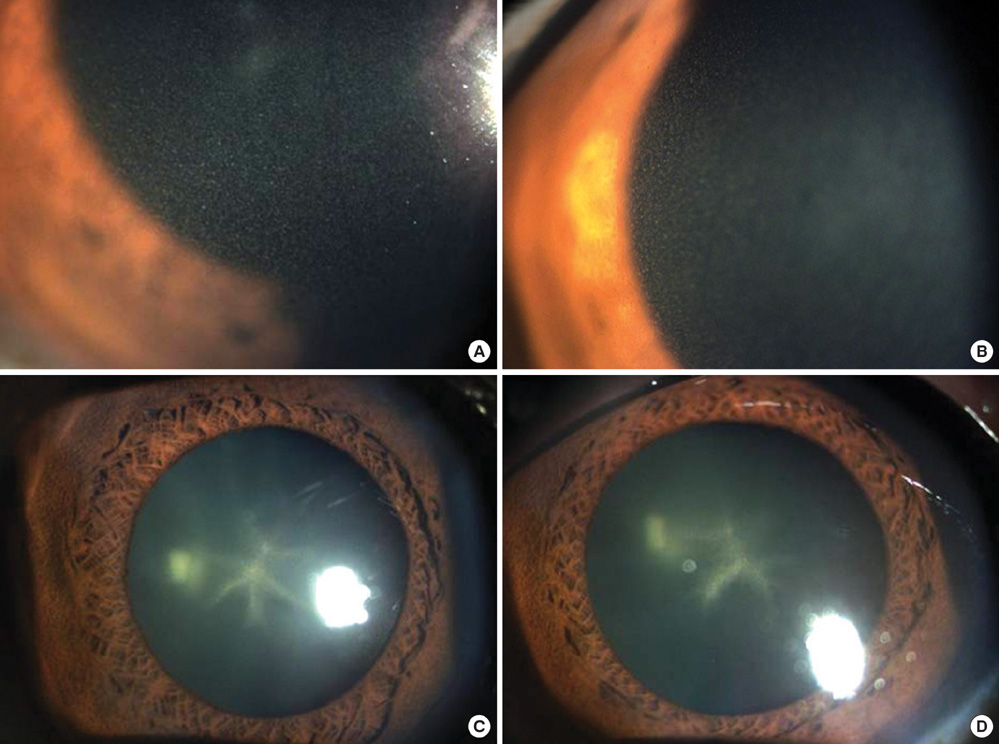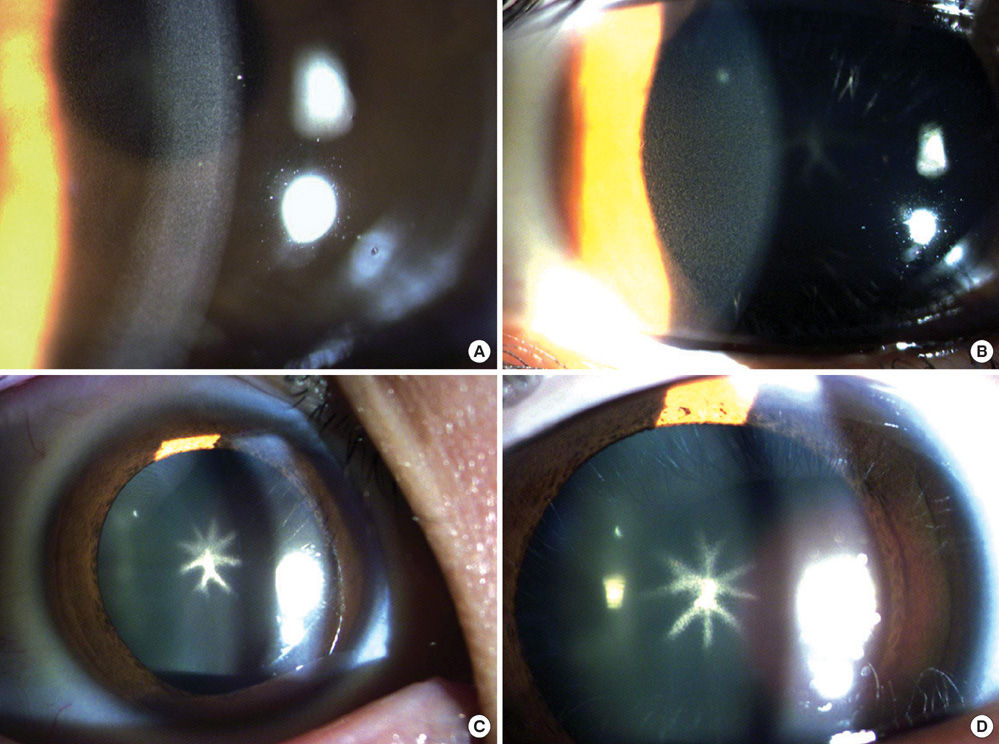J Korean Med Sci.
2010 Nov;25(11):1688-1691. 10.3346/jkms.2010.25.11.1688.
Methotrimeprazine-induced Corneal Deposits and Cataract Revealed by Urine Drug Profiling Test
- Affiliations
-
- 1Department of Ophthalmology, Chosun University College of Medicine, Gwangju, Korea. clearcornea@paran.com
- 2Department of Ophthalmology, Kangbuk Samsung Hospital, Sungkyunkwan University School of Medicine, Seoul, Korea.
- 3Department of Emergency Medicine, Asan Medical Center, Ulsan University College of Medicine, Seoul, Korea.
- KMID: 1779246
- DOI: http://doi.org/10.3346/jkms.2010.25.11.1688
Abstract
- Two schizophrenic patients who had been taking medication for a long period presented with visual disturbance of 6-month duration. Slit-lamp examination revealed fine, discrete, and brownish deposits on the posterior cornea. In addition, bilateral star-shaped anterior subcapsular lens opacities, which were dense, dust-like granular deposits, were noted. Although we strongly suspected that the patient might have taken one of the drugs of the phenothiazine family, we were unable to obtain a history of medications other than haloperidol and risperidone, which were taken for 3 yr. We performed a drug profiling test using urine samples and detected methotrimeprazine. The patient underwent surgery for anterior subcapsular lens opacities. Visual acuity improved in both eyes, but the corneal deposits remained. We report an unusual case of methotrimeprazine-induced corneal deposits and cataract in a patient with psychosis, identified by using the urine drug profiling test.
Keyword
MeSH Terms
-
Adult
Antipsychotic Agents/*adverse effects/therapeutic use/urine
Cataract/*chemically induced
Corneal Diseases/*chemically induced
Female
Humans
Male
Mental Retardation/diagnosis/drug therapy
Methotrimeprazine/*adverse effects/therapeutic use/urine
Middle Aged
Schizophrenia/diagnosis/drug therapy
Visual Acuity
Figure
Reference
-
1. Greiner AC, Berry K. Skin pigmentation and corneal and lens opacities with prolonged chlorpromazine therapy. Can Med Assoc J. 1964. 90:663–665.2. Howard RO, McDonald CJ, Dunn B, Creasey WA. Experimental chlorpromazine cataracts. Invest Ophthalmol. 1969. 8:413–421.3. Jung BS, Lee TH, Lee HY. Ocular findings associated with long-term chlorpromazine therapy. J Korean Ophthalmol Soc. 1996. 37:1951–1957.4. Kim HS, Choi HJ, Yun YS. Two cases of chlorpromazine-induced corneal and lenticular opacity. J Korean Ophthalmol Soc. 2002. 43:2349–2353.5. Potts AM. The concentration of phenothiazines in the eye of experimental animals. Invest Ophthalmol. 1962. 1:522–530.6. McCarty CA, Wood CA, Fu CL, Livingston PM, Mackersey S, Stanislavsky Y, Taylor HR. Schizophrenia, Psychotropic medication and Cataract. Ophthalmology. 1999. 106:683–687.
Article7. Ruigómez A, García Rodríguez LA, Dev VJ, Arellano F, Raniwala J. Are schizophrenia or antipsychotic drugs a risk factor for cataracts? Epidemiology. 2000. 11:620–623.
Article8. DeLong SL, Poley BJ, McFarlane JR Jr. Ocular changes associated with long term chlorpromazine therapy. Arch Ophthalmol. 1965. 73:611–617.9. Thaler JS, Curinga R, Kiracofe G. Relation of graded ocular anterior chamber pigmentation to phenothiazine intake in schizophrenics--quantification procedures. Am J Optom Physiol Opt. 1985. 62:600–604.
Article10. Lal S, Bloom D, Silver B, Desjardins B, Krishnan B, Thavundayil J, Thompson T. Replacement of chlorpromazine with other neuroleptics: effect on abnormal skin pigmentation and ocular changes. J Psychiatry Neurosci. 1993. 18:173–177.11. Huang MK, Dai YS, Lee CH, Liu C, Tsay WI, Li JH. Performance characteristics of DRI, CEDIA, and REMEDi systems for preliminary tests of amphetamines and opiates in human urine. J Anal Toxicol. 2006. 30:61–64.
Article
- Full Text Links
- Actions
-
Cited
- CITED
-
- Close
- Share
- Similar articles
-
- In Vivo Confocal Microscopic Findings of Corneal Tissue in Amiodarone-Induced Vortex Keratopathy
- Clinical Evaluation of Traumatic Cataract with Corneal Laceration
- Corneal Astigmatism after Cataract Surgery: The Effect of Electrocautery
- Early Result of Corneal Astigmatism in Sutureless Cataract Surgery
- Two Cases of Paraproteinemic Keratopathy



